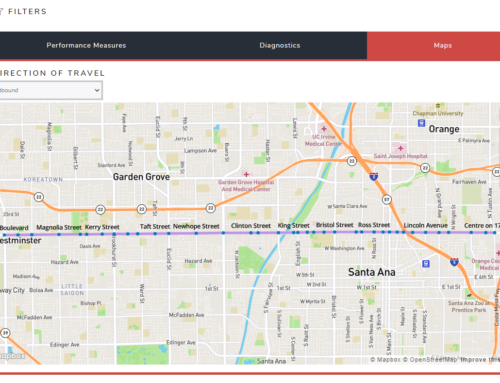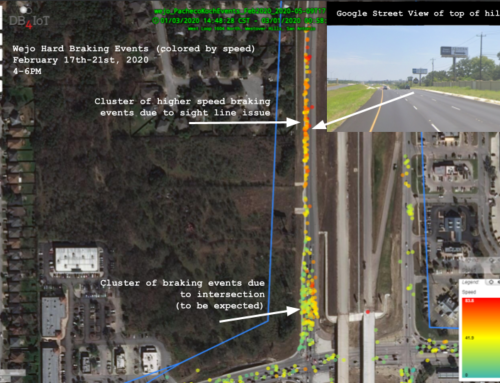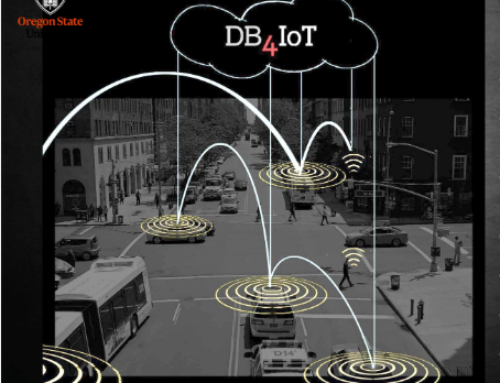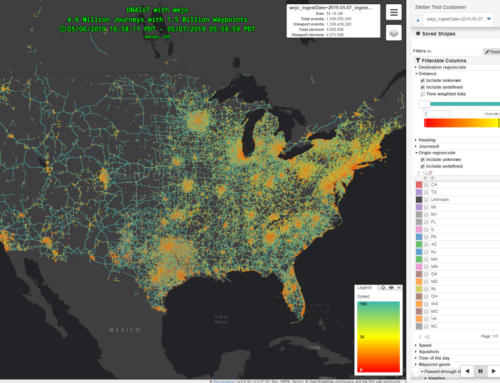Moonshadow Mobile has released DB4IoT Route Analyst GTFS for the Regional Transportation District (RTD) in Denver, Colorado. The RTD provides public transit throughout the greater Denver region servicing towns from Longmont, Boulder and Lafayette in the North to Sheridan, Englewood, Aurora, Littleton and Centennial and all the way to Parker, CO, in the South.
The RTD makes its schedule available as a GTFS file whenever the schedule changes. The RTD also publishes the movement of all its buses and trains in real-time as a GTFS Real Time Vehicle Position file. Route Analyst GTFS tracks all vehicle movement live and retains all movement data.
Route Analyst GTFS – Special Introductory Pricing: $199/month or $1,995/year
The above image shows the speed for all RTD vehicles between November 13 and November 27, 2017. The RTD reported almost 6.5 million vehicle movements in this time period, all of which were retained in Route Analyst.
With Route Analyst users can see all RTD vehicle movement in real time and play back vehicle movement for any bus or train at any moment in the past from the time Moonshadow started to track the RTD.
The RTD updates the vehicle location files every 20-40 seconds. When Route Analyst is set to Live Mode users will see the last reported location for every bus and train. To see information on a particular vehicle just zoom in and click on the object.
Route Analyst GTFS generates a very rich set of variables that give transit planners and engineers a wealth of information. Route Analyst GTFS tracks the acceleration, delay, headway, speed, distance from the route as well as the route progress. The software also tracks the day and time and it has easy selectors to allow analysts to quickly compare route performance on, for example, evening peak hours over a month of time.
The above image shows that the average delays on Route 15L Westbound were decreasing every day during the week running up to the Thanksgiving Holidays. The week of November 13, which did not have a holiday, showed the normal delay pattern.
The above image shows the weekday travel times for the JUMP route in Boulder, CO. The dotted line shows the standard deviation from the mean. The farther the dotted line is from the mean, the less reliable the service. Travel time charts can be generated in seconds for any route in any direction for any type of day and time of day.
With Route Analyst GTFS transit planners can instantly generate heat charts to get a deep understanding of their route performance.
In the above heat chart the X-axis shows the distance traveled along Route 15L Eastbound on weekdays. The Y-axis shows the time of day and the resulting grid is colored by the average speed of the buses. With a heat chart like this transit planners can instantly see where and when bus speeds are the lowest. This provides a powerful tool to get insight in when delays are incurred as a result of traffic along the route.
Route Analyst GTFS includes a feature where analysts can open two or more views on the movement data. This allows analysts to instantly compare different routes, different route shapes, different directions or different time periods or the same route.
The above image shows the RTD “Jump” route in Westbound in Boulder, Colorado. In the top half of the image the graph shows the travel times along this route on weekends with a speed map of all reported movements. In the bottom half the graph shows the travel times along this route on weekdays with a speed map. Transit analysts can generate these comparisons instantly to compare service performance.
With Route Analyst GTFS transit planners can instantly compare the performance of all routes and directions over any time period and look at this in tables.
The above chart shows all RTD routes in each direction on weekdays for the period from November 13-27. The data is sorted by delay and it shows that the LOOP route in Direction 0 had an average delay of 713 seconds. The second worst was Route 35 Eastbound (Direction 0) with an average delay of 418 seconds. The image below looks at the same data sorted by a different variable.
The data is now sorted by the standard deviation of Headway Deviation. This is an indicator of reliability. Route Analyst tracks headway for every route in every direction and compares this to the scheduled headway for that moment in time. The resulting value is stored as the Headway Deviation. The larger the standard deviation from the mean for the headway deviation, the more unpredictable the service was on this line.
Route Analyst GTFS runs in the cloud and requires no investment in servers or technical staff. Pricing for Route Analyst GTFS starts at only $199 per month.
Please let us know if you need access to Route Analyst GTFS for a transit agency that Moonshadow has not yet released. A video showing the power of Route Analyst GTFS is available here. https://db4iot.com/route-analyst-gtfs/
 Route Analyst GTFS was developed in close cooperation with DKS Associates, a leading transportation consulting firm in Portland, Oregon, and data engineers from TriMet, the public transit agency serving the Portland, Oregon metro area.
Route Analyst GTFS was developed in close cooperation with DKS Associates, a leading transportation consulting firm in Portland, Oregon, and data engineers from TriMet, the public transit agency serving the Portland, Oregon metro area.
Route Analyst GTFS – Special Introductory Pricing: $199/month or $1,995/year











